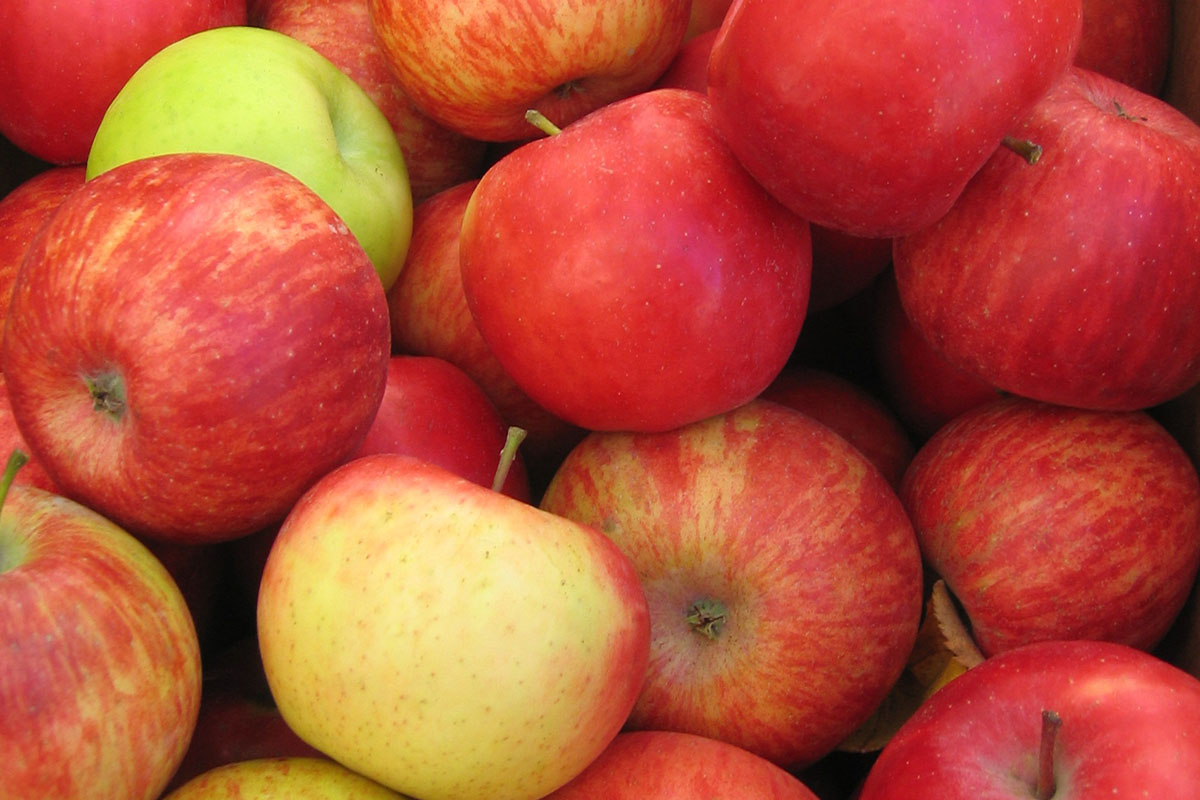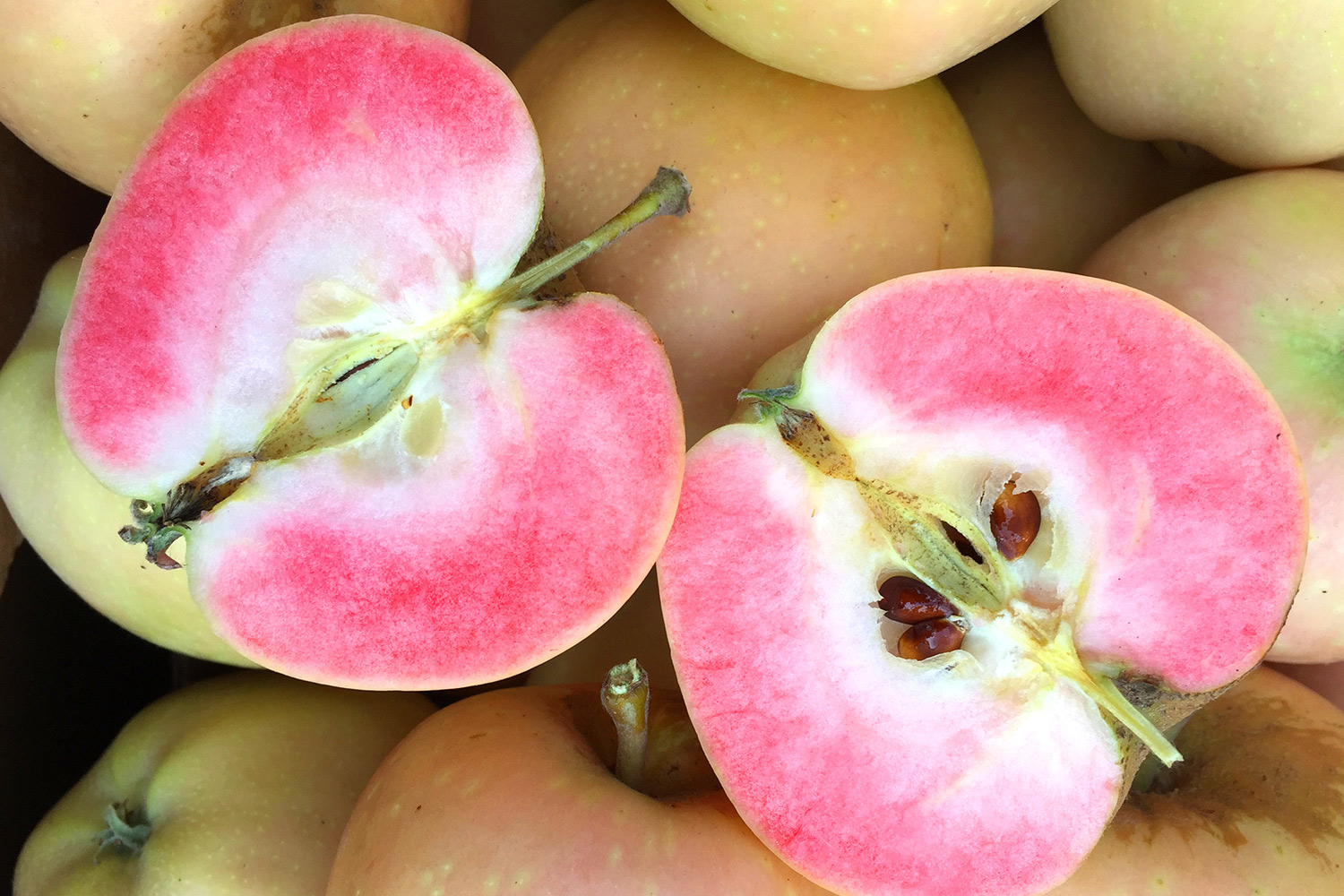From Arkansas Black to Winesap: A Farmers Market Guide to Apples
October 17, 2019

August through November is peak apple season at California’s farmers markets. At grocery stores, you might only find a handful of apples such as Red Delicious, Fuji, and Granny Smith, but at the farmers market, you’ll find more than 50 fresh and flavorful varieties with evocative names like Mutsu, Gravenstein, and Black Twig, each available for a brief, delicious window of time.
But the apple tree branches out even more. There are more than 7,500 cultivars of apples worldwide, most of which are harvested for eating, while some are specifically cultivated for cooking or making into cider. These varieties range from tart to sweet, crunchy to juicy, and deep red to golden-green.

What Makes an Apple an Heirloom?
Apples contain an incredible amount of genetic variation in a single seed, and each fruit contains a unique combination of genes. Apples are heterozygotes, which means that when an apple seed is planted and grows into a tree, it won’t resemble the parent tree. In order to grow a particular variety of apple, farmers have to cut a shoot from the original tree and graft it onto rootstock.
Industrial agriculture tends to prioritize a few apple varieties for their uniformity, suitability for cold storage, and transportation hardiness. However, heirloom apples have been bred by orchardists over the centuries for a wide range of tastes, textures, sizes, and shapes. Within the couple hundred years, there were thousands of unique apple varieties grown domestically in the United States.
California used to be a top apple producer, however, many of orchards have been lost to land development and competition from overseas. You can still find signs of California’s apple legacy at the farmers market, and fall is the best time to explore some of these historic varieties when they’re freshly harvested.
We’ve put together a list of some of the more popular heirloom varieties you’ll find at the farmers market throughout the season. Their approximate harvest times are noted in parenthesis, based on Devoto Orchards’ website.

A Field Guide to Apples
Arkansas Black (late October-mid November): A crowd favorite, the Arkansas Black is notable for its extremely dark color. The taste is sweet, tart, and crunchy on the inside. Although the Arkansas Black is great for baking, it doesn’t hold shape when cooked. However, you can use it for cider-making and cheese pairings. Store it in the refrigerator to increase its sweet flavor.
Black Twig (late October-early November): Black Twig apples are tart, firm, and juicy on the inside with burgundy and light green skin. The Black Twig apple is a dessert apple, appropriate for eating fresh and cider-making.
Gala (late August-October): The Gala was brought to the U.S. in the early 1970s, making it now one of the country’s most popular varieties, surpassing Red Delicious as the highest produced cultivar in the nation. The red and yellow-striped apple is a cross between Kidd’s Orange Red and Golden Delicious. Its crisp, juicy, and very sweet taste makes it suitable for snacking.
Granny Smith (late October): Another common commercially grown variety, the Granny Smith was discovered in 1868 in New South Wales, Australia, by British-Australian orchardist Maria Ann Smith. One of its parents might have been a French crabapple from Tasmania. Grannies are known for their bright green skin and very tart flavor. Because of their versatility, Grannies are delicious for snacking, baking into pies, and turning into apple sauce.

Gravenstein (early August): Considered an important heritage variety worth preserving by Slow Food USA, the Gravenstein was discovered in 1669 in South Denmark and brought to the U.S. in the early 19th century. A hallmark of Sebastopol, the Gravenstein is rich with tartness and well suited for sauces, pies, and ciders. It is one of the first apples of the season at CUESA’s farmers markets and tends to wind down heading into fall.
Hawaiian (late September-late October): Despite the name, these apples are not from Hawaii. They’re locally grown in Sebastopol, an offspring of the Gravenstein. The Hawaiian is low in acidity with a very sweet and aromatic taste. It also bruises very easily, but it’s excellent for baking.
Jonagold (early October): The Jonagold is a cross between the Jonathan and Golden Delicious varieties. It is a large apple with crimson color skin and yellow-green background. Jonagolds have a sweet-tart flavor and crispy, juicy, and partially yellow flesh, suitable for snacking on fresh and cooking.
Mutsu (mid September-late October): Also known as the Crispin, the Mutsu is a cross between Golden Delicious and Indo, a Japanese cultivar. This dessert apple was named after the Mutsu Province of Japan. The aromatic, sweet, and crisp flavor and juicy flesh makes it suitable for eating on its own, but you can also use it for juicing, drying, and cooking.

Pink Pearl (August): Another cult favorite, the Pink Pearl is known for its rosy skin and bright pink flesh. It has a tart and spicy flavor, and its vibrant hue makes a striking addition to baked goods and sauces. Pink Pearls are not widely grown and tend to have a short harvest season.
Sierra Beauty (mid October): Originating from the Sierra Nevada Mountains in 1870, the Sierra Beauty has a white flesh with a crisp and moderately sweet flavor. Use these tart apples for baking, snacking, and making into apple cider.
Swaar (October): Swaar means “heavy” in Dutch, which describes this apple’s large size and dense flesh. Swaar apples have rough yellow-green skin with some brown patches, known as russeting. The texture softens over time if stored well, making the apple buttery and tender. We recommend putting them in the refrigerator for a few weeks before eating to taste their full flavor.
Wickson (late September-early October): Unlike their larger apple counterparts, the Wickson is a crab apple, making it a small but flavorful fruit. Its parents are a Spitzenburg crab and a Newton crab. Its small size makes it a fun snack, but its sharp yet sweet taste also make it suitable for juicing and cider-making.
Winesap (late October-early November): The Winesap is a well-known heirloom variety that has a spicy wine-like flavor with a balanced tart and sweet taste. Winesap apples have a dark red skin with a crisp and juicy flesh. It is a versatile apple for cider-making, sauces, juicing, preserving, and baking.
Visit the Devoto Gardens website for more information on apple varieties, and stop by their farm stand at the Ferry Plaza Farmers Market on Saturdays.
Discover more varieties of apples and which farms grow them at CUESA’s farmers markets here. For recipe inspiration, check out our recipe archive.
Illustration by CUESA Intern Abigail Park.
Topics: Fruit, Produce guides